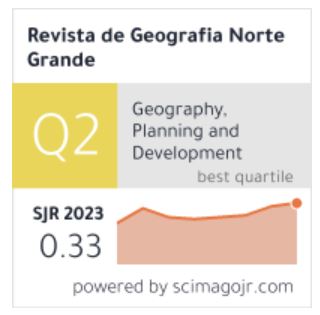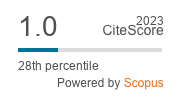Mountain landslides and moraines in the Chilean Andes
Keywords:
Landslides, moraines, Chilean AndesAbstract
Due to intense erosion in the Andean valleys, the terminal and marginal moraines of the last Pleistocene glaciation were preserved only under favorable morphological conditions. In the case of many barriers and valley steps in the Chilean Andes that were interpreted so far as moraines, they are not glacial deposits, but debris bodies of powerful prehistoric mountain landslides.
Against a glacial genesis and in favor of a mountain landslide interpretation of these debris bodies, we have their extraordinarily large thickness compared to the moraines of the neighboring valleys, the size of the individual blocks, their decompaction without loss of coherence, the absence of rounding of the material, as well as local reasons (especially the petrographic composition). An investigation of the distribution of prehistoric mountain landslides has also a practical significance. According to experience, mass movements occur with particular frequency precisely where mountain landslides had previously originated. In the largely uninhabited Chilean Andean valleys, the dangers of mountain landslides are not as great as in densely populated Andean mountain ranges, especially in Peru. Nevertheless, a potential hazard occurs as a consequence of mountain landslides, especially due to the damming and subsequent rupture of lakes and as a result of which the lower sectors of the valleys and even the Chilean intermediate depression may be flooded. Special attention should be paid to the region of the Laja River, where the Laja Lagoon is dammed by fills from the young Antuco volcano, which is located in the middle of the valley. Rupture lake sediments deposited here in the recent geological past are indicative that slow or rapid lake ruptures may also be repeated in the future.
Downloads
References
.......1981: Trockene Massenbewegungen, chlammstrome und rasche Abflüsse, dominante morphologische Vorgiinge in den chilenischen Anden. En: Mainzer Geographische Studien, Heft 23, Mainz 1981,102 págs.
BORDE, J. 1966: Les Andes de Santiago et leur avantpays. Bordeaux, 559 págs.
BORGEL, R.1963-64: La carta geomorfológica de Chile. En: Rev. Geogr., Univ. de los Andes, Vol. IV u. V, Mérida, pp. 15-22.
BRUGGEN, J. 1942: El volcán Antuco y la geología glacial del valle del Laja. Santiago, Chile, 35 págs.
1946: La cronología de las épocas glaciales de Chile. En: Revista Universitaria, Santiago, Chile, pp. 27-38.
1950: Fundamentos de la geología de Chile. Santiago, 374 págs.
CAVIEDES, C. 1972: Geomorfología del cuaternario del valle del Aconcagua, Chile Central. En: Freiburger Geographische Hefte, 11, Freiburg, 153 pág.
CAVIEDES, C. y R. PASKOFF 1975: Quaternary Glaciations in the Andes of North Central Chile. En: Journal of Glaciology, Vol. 14, NO 70, pp. 155-169.
DAVIS, S. y J. KARZULOVIC 1961: Deslizamientos en el valle del río San Pedro, provincia de Valdivia, Chile. En. Universidad de Chile, Facultad de Ciencias Físicas y Matemáticas, Instituto de Geología, publicación NO 20, Santiago, Chile, pp. 53-108.
ENRIONE, A. y P. VILLARROEL 1962: Geología del área de la Central Hidroeléctrica El Toro (provincia de Ñuble). Escuela de Geología, Universidad de Chile, Memoria de Prueba. Santiago, Chile, 75 págs.
ERISMANN, T.H. 1979: Mechanism of large Landslides. En: Rock Mechanics, 12, pp. 15-46.
LANKENAU, E. 1958: Tinguiririca, Vulkanismus und Vereisung als formende Elemente der mittelchilenischen Hochkordillere. En: Petermanns Geographische Mitteilungen, Erg.-H. 267, Gotha, 78 págs.
Mac PHAIL, D. 1966: El gran lahar del Laja. En: Estudios Geográficos, Santiago, Chile, pp. 133-155. 1973: The Geomorphology of the Río Teno- Lahar, Central Chile. En: Geographical Review, Vol. 63, pp. 517-532.
MARANGUNIC, C. y R. THIELE. 1971: Procedencia y determinaciones gravimétricas de espesor de la morrena de la Laguna Negra, provincia de Santiago. En: Universidad de Chile, Facultad de Ciencias Físicas y Matemáticas, Departamento de Geología, Publicación NO38, Santiago, Chile, 25 págs.
PASKOFF, R. 1970: Recherches géomorphologiques dans le Chili semiaride. Bordeaux, 420 págs.
TAZIEFF, H. 1960: Interprétation des glissements de terrain accompagnant le grand séisme du Chill. En: Bulletin Soco Géologique Beige, Liege.
VERGARA, M. ~' Y. KATSUI, 1969: Contribución a la geología y petrología del volcán Antuco, Cordillera de los Andes, Chile Central. En: Publicaciones del Departamento de Geología de la Universidad de Chile, Publ. NO35, Santiago, Chile, pp. 25-47.
VIERS, G. 1978: Morphologie glaciaire dans les hautes montagnes seches: les Andes chiliennes vers 300 de latitude Sud. En: Revue de Géographie Alpine, tome 66, pp. 437-459.
WEISCHET, W. 1960: Die geographischen Auswirkungen des Erdbebens vom 22. Mai
.....1960 irn Kleinen Süden Chiles. En: Erdkunde, Bd. 14, pp. 273-288.
.....1963a: Further Observations of geologic and geomorphic Changes resulting from the catastrophic Earthquake of May 1960 in Chile. En: Bull. of the eismological Society of America, vol. 53, NO6, pp. 1237-1257.
.....1963b: The Distribution of the Damage caused by the Earthquake in Valdivia in relation to the form of the terrain. En: Bull. of the Seismological Society of America, Vol. 53, NO6, pp. 1259-1262.
.....1970: Chile, seine liinderkundliche Individualitiit und Struktur. Darmstadt, 618 págs.






